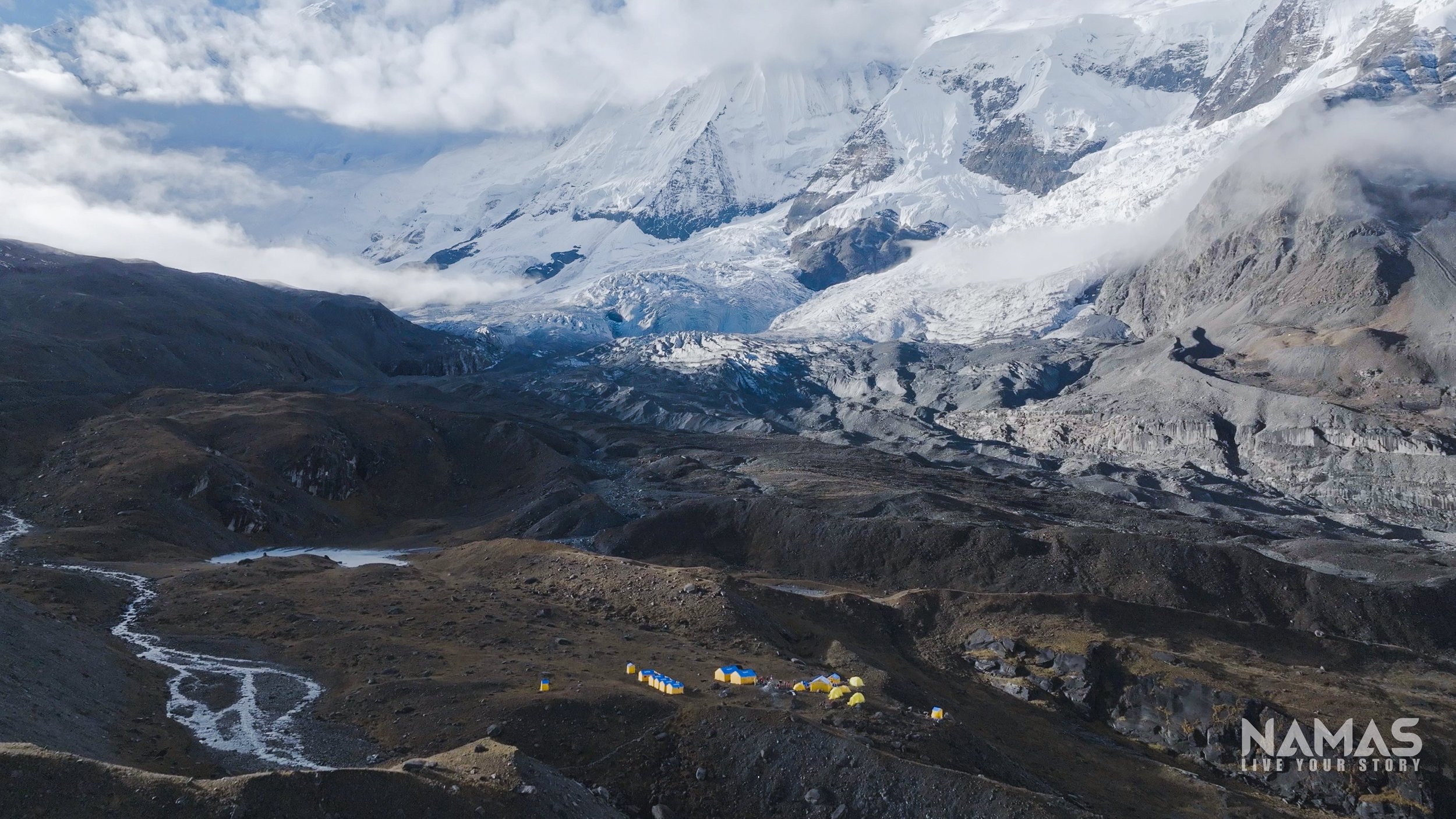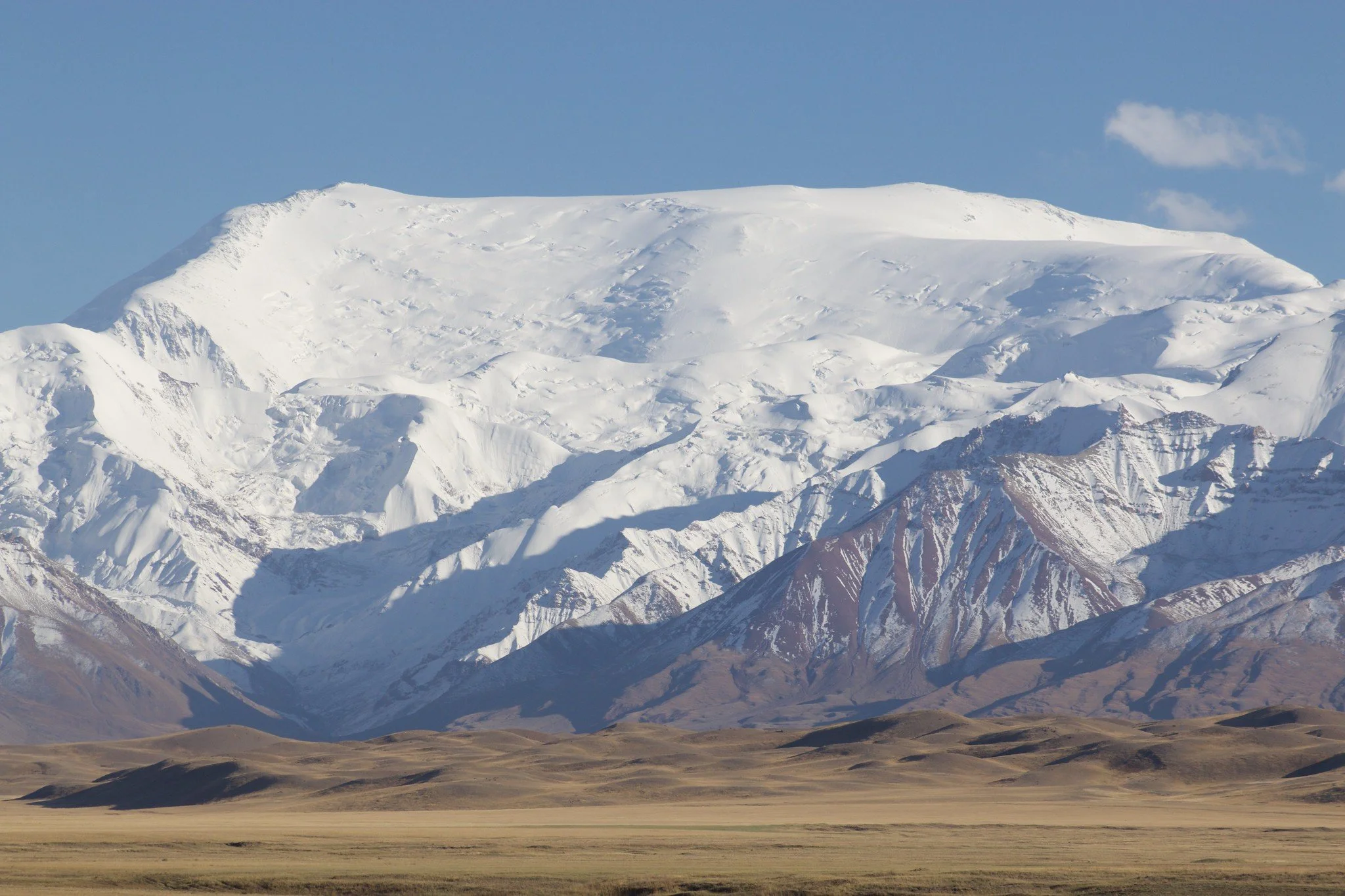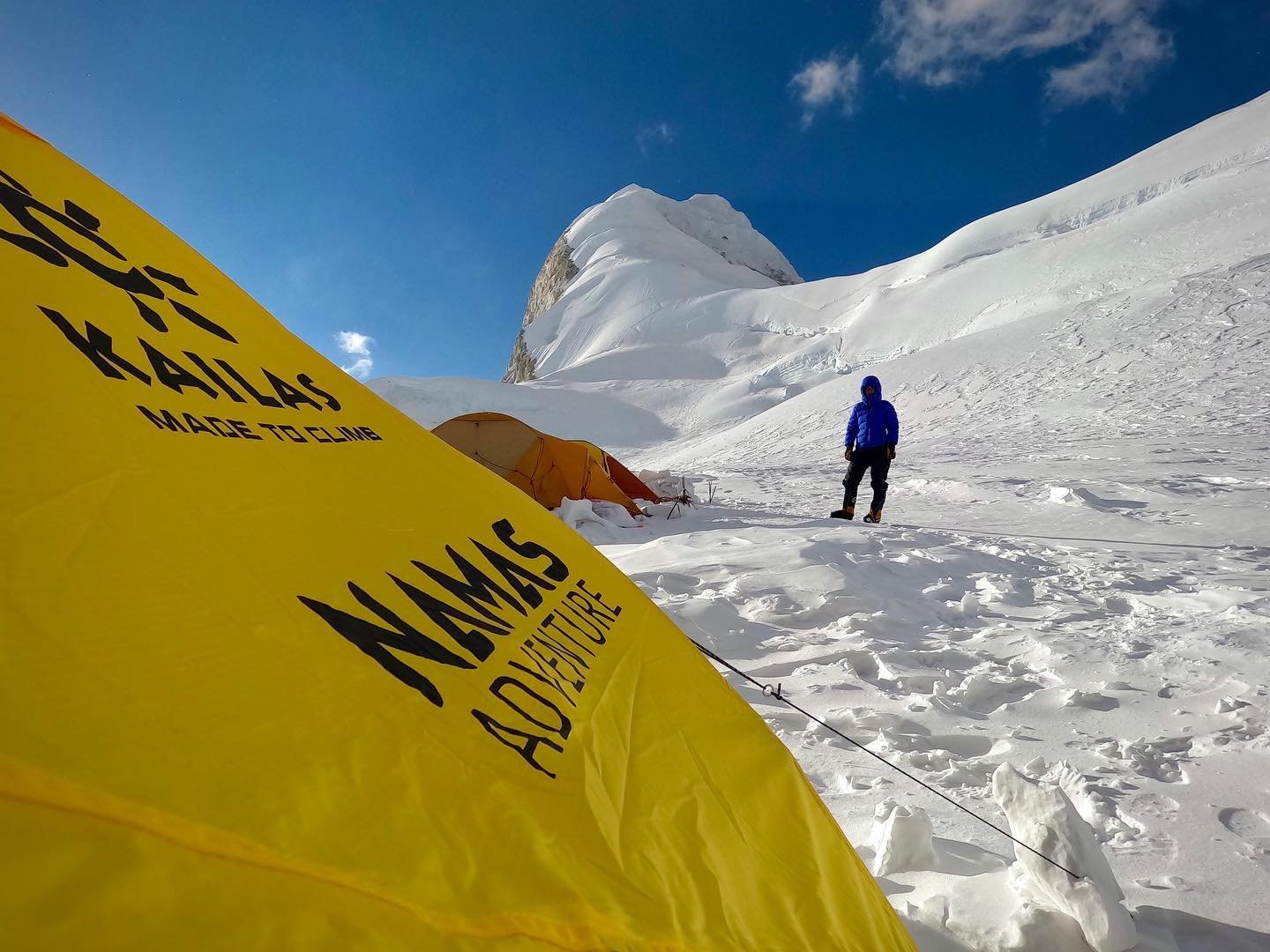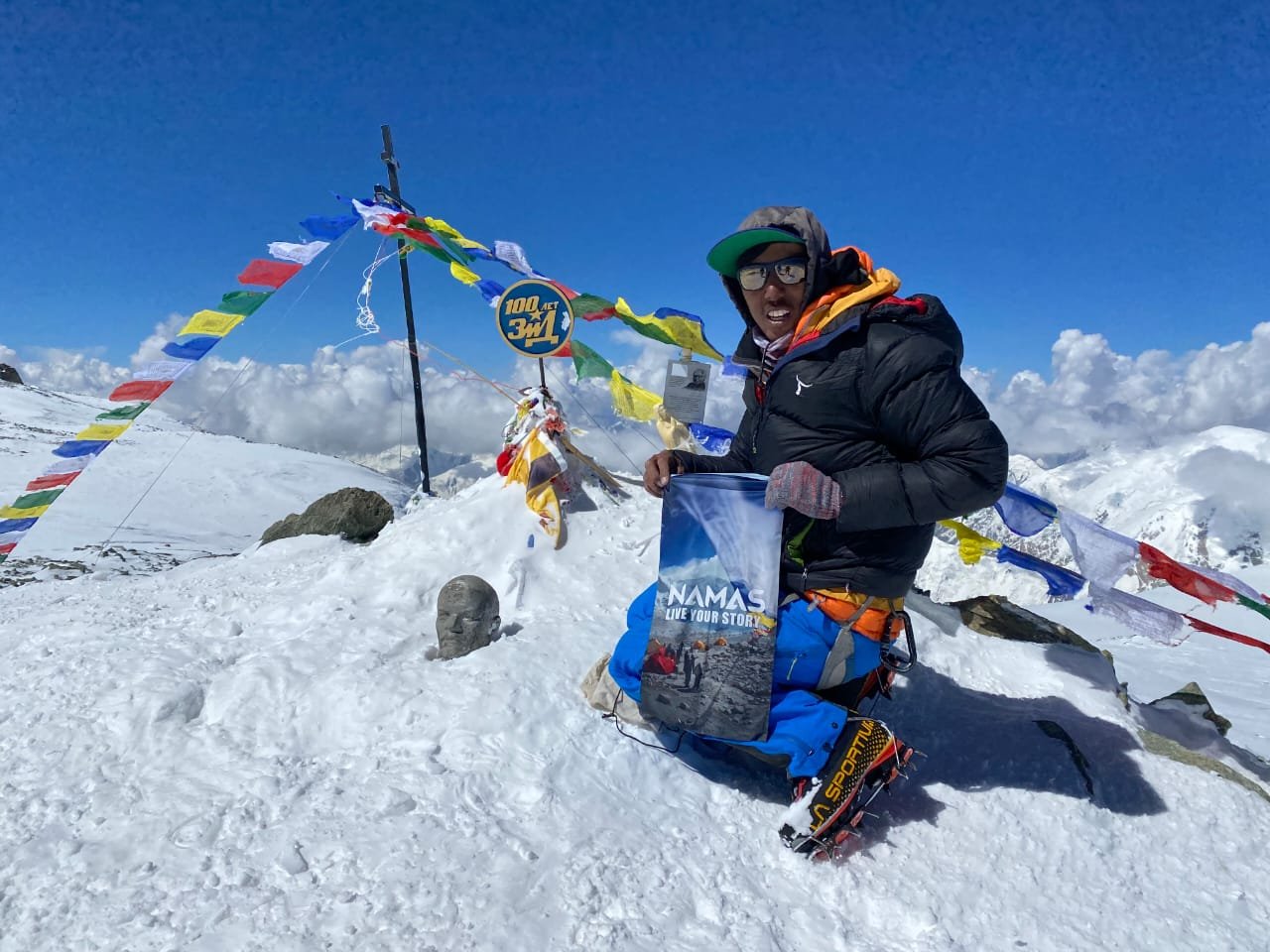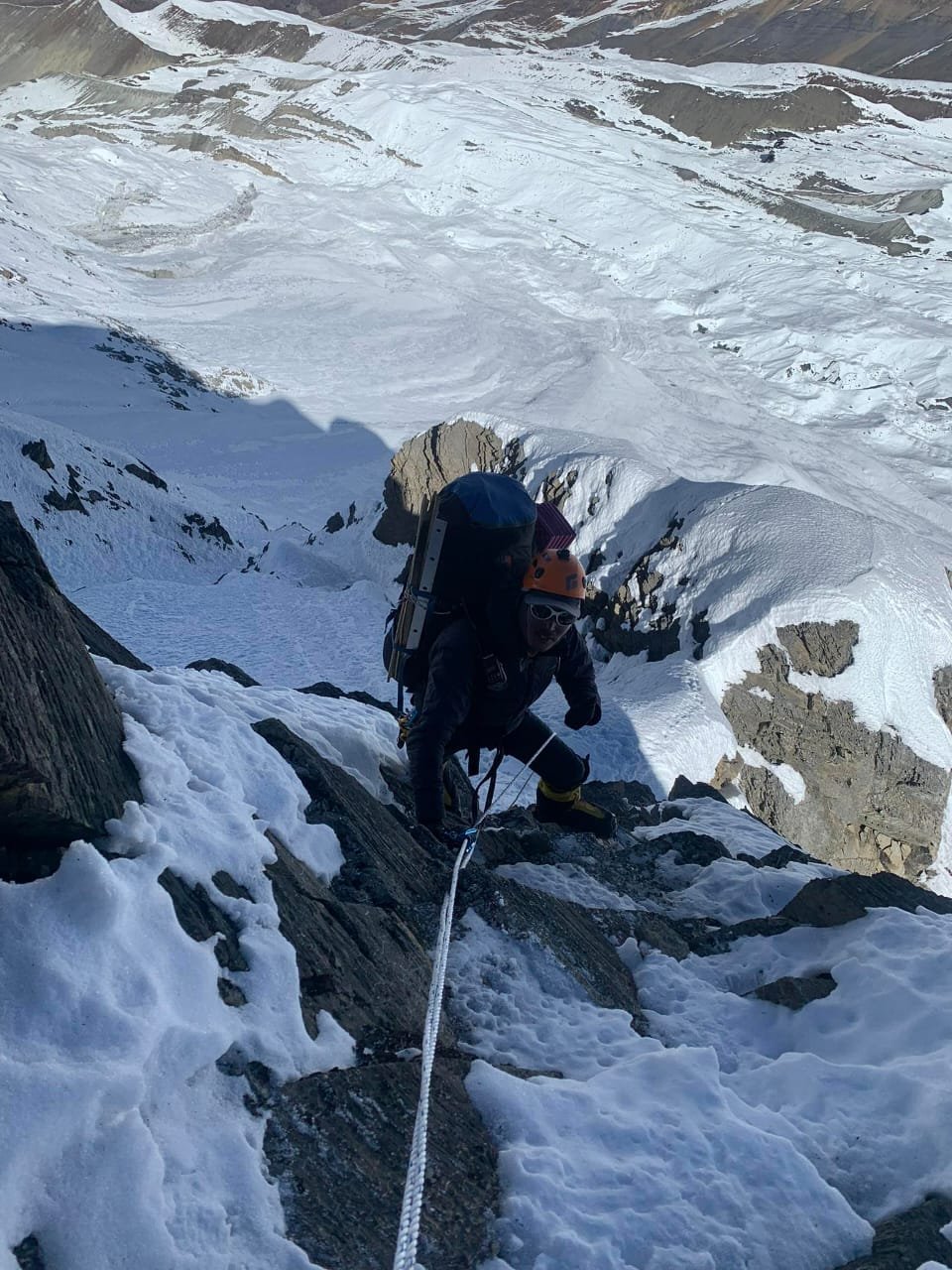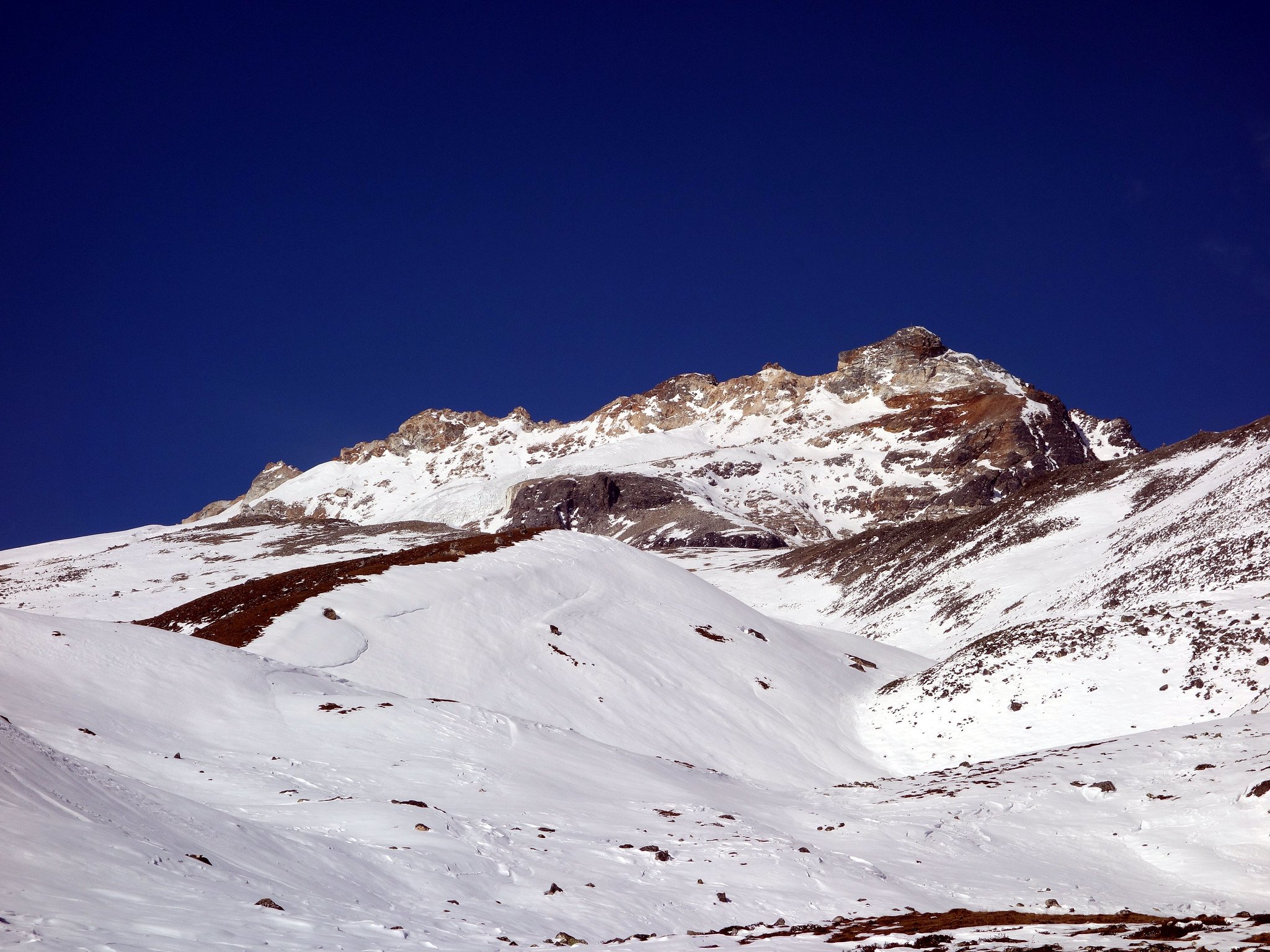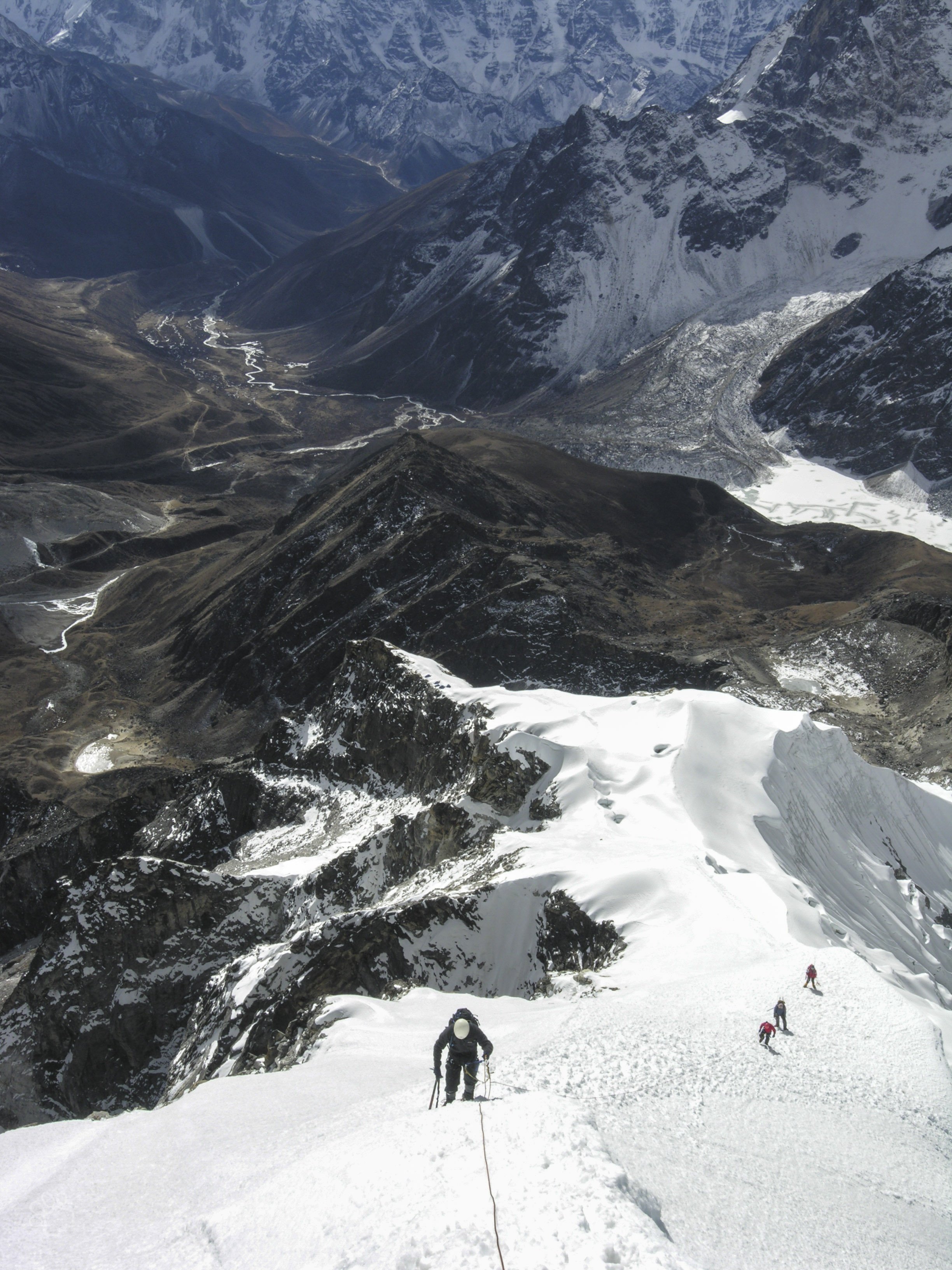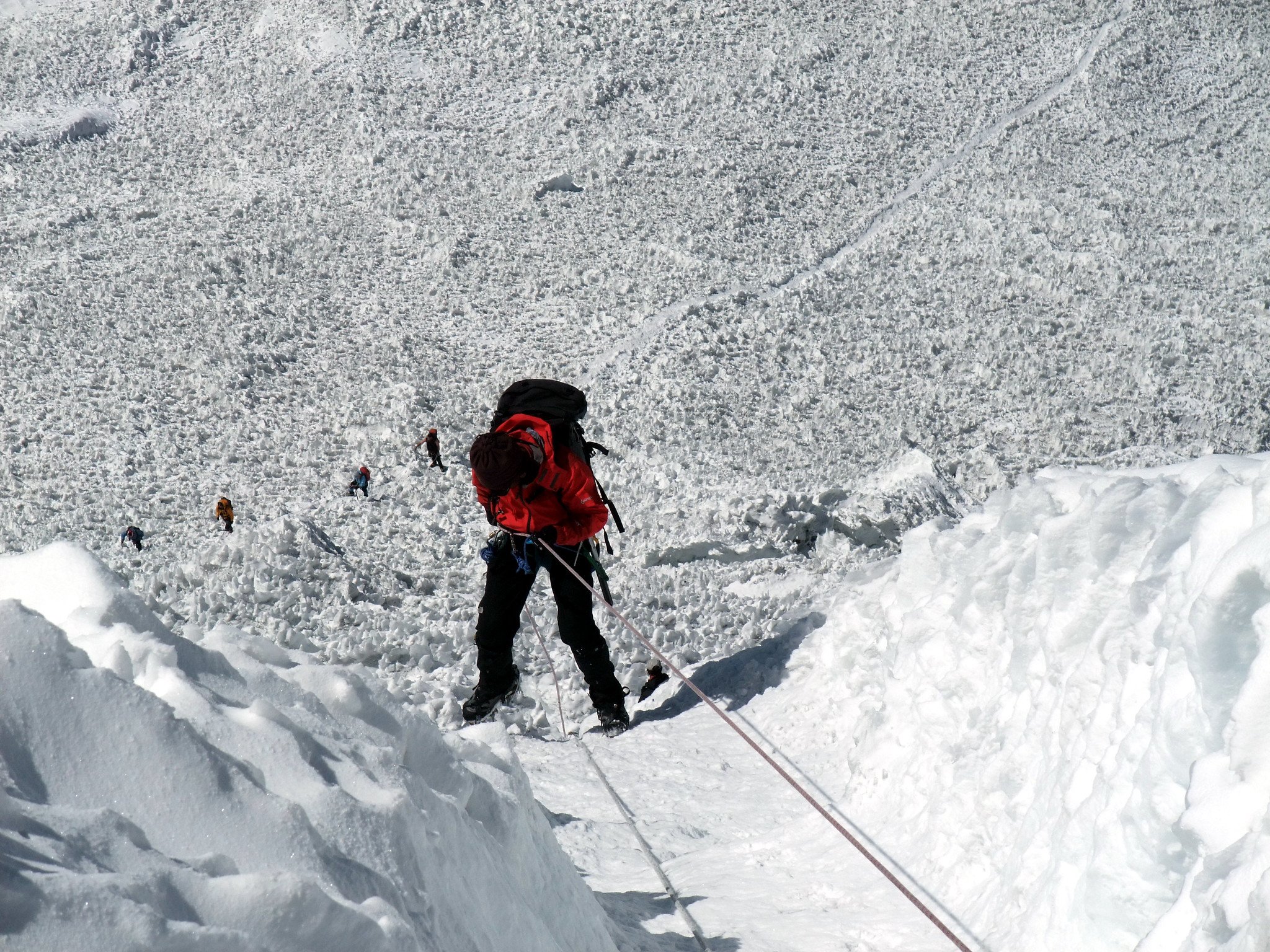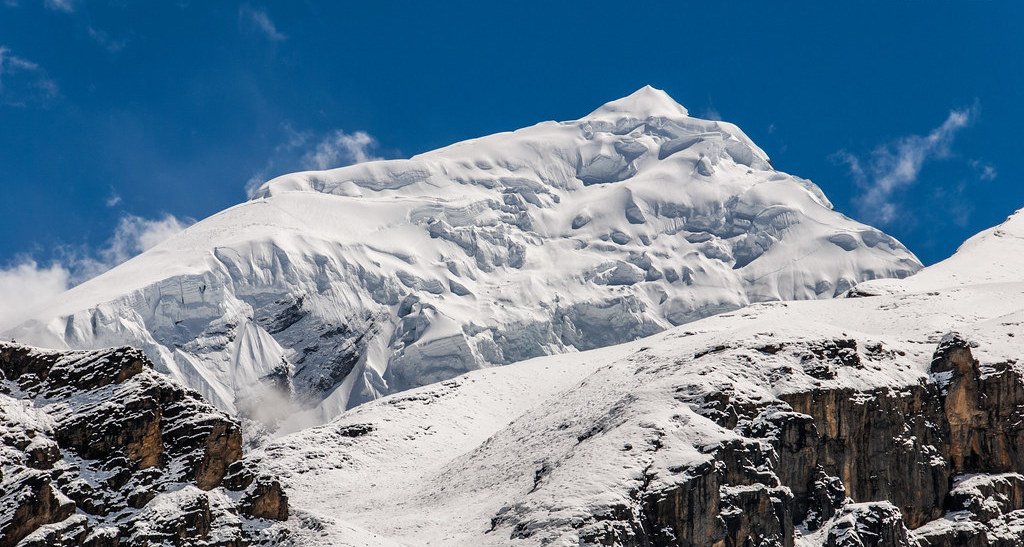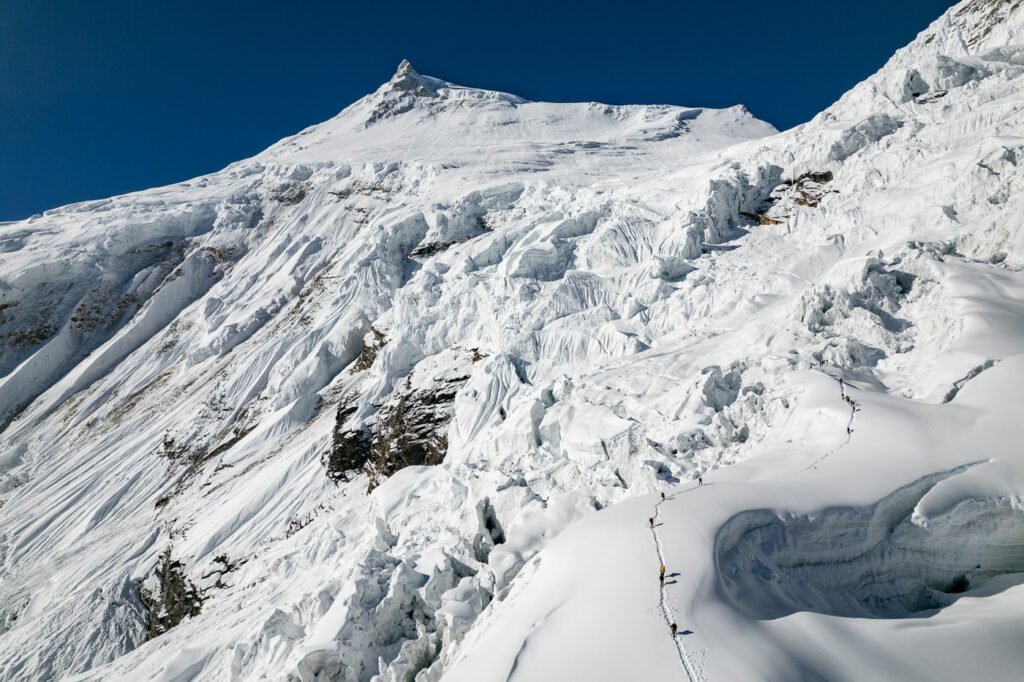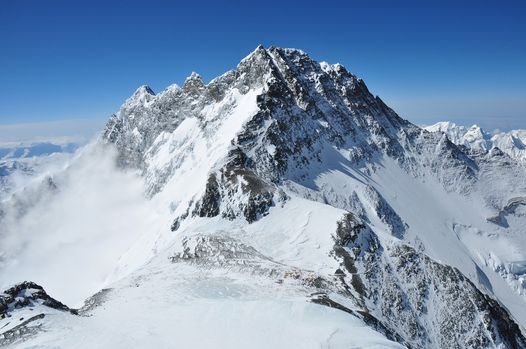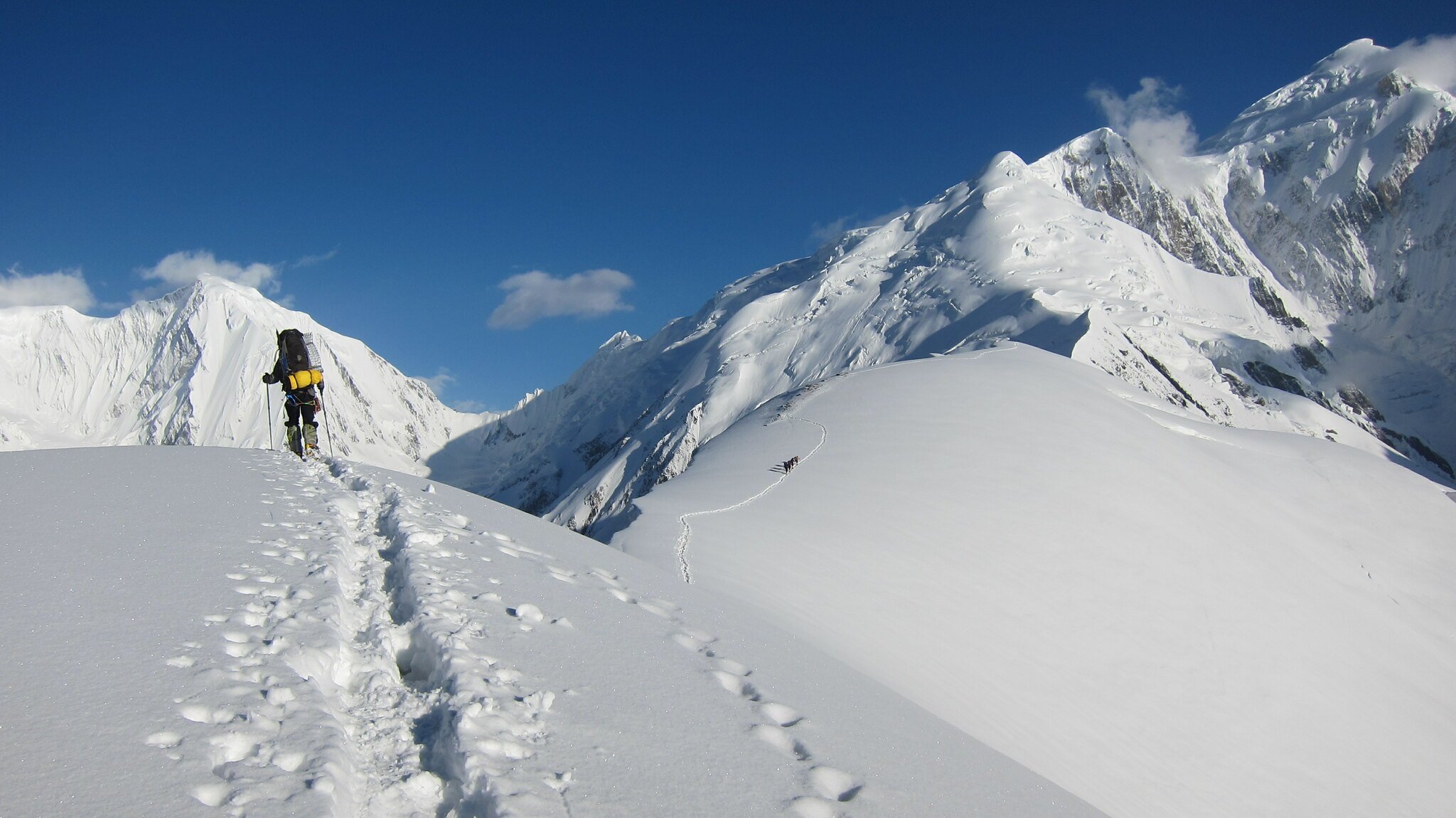Comparing 7000M Peaks: Which One is Right for Your Next Expedition?
Annapurna IV 7525M summit seen in the middle with Annapurna 2 on the left.
Perhaps you have completed several 4,000m to 6,000m summit expeditions and are now seeking a greater challenge. You might be exploring 7,000m mountains to enhance your high-altitude mountaineering experience, with aspirations of climbing Everest or one of the other 8,000m peaks. Alternatively, you may simply wish to immerse yourself in the pure exploration and remoteness that these high-altitude adventures offer.
Unsure on which 7000M peak to choose? In this blog post, we compare five prominent 7,000m mountain expeditions—Annapurna IV 7525M, Baruntse 7129M, Tilicho Peak 7134M, Himlung Himal 7126M, and Lenin Peak 7134M—to help you make an informed decision for your high-altitude journey.
1. Annapurna IV (7,525m)
Location: Annapurna Range, Nepal
Level: Advanced level
Technical Difficulty: High
Best Time to Climb: Spring (April-May) and Autumn (September-October)
Duration: 30 days
Key Features: Annapurna IV is a remote and lesser-climbed peak in the Annapurna range, known for its technical challenges. Climbers must have advanced skills in rock and ice climbing, as the route includes steep sections, exposed ridges, and deep snow. The peak's isolation offers a more immersive and adventurous experience, but it also demands excellent logistical planning. With only about 150 people ever reaching the summit, Annapurna IV is ideal for seasoned mountaineers seeking a quieter climb.
P.s. - Annapurna IV can be your expedition to prepare for Everest, Annapurna 1 or K2 expeditions.
Pros: Quieter, remote, and ideal as preparation for Everest or technical 8000m peaks.
Cons: Avalanche risk, technical sections, and steep terrain make it unsuitable for beginners.
2. Baruntse (7,129m)
Location: Barun Region, Nepal
Level: Intermedaite level
Technical Difficulty: Moderate to High
Best Time to Climb: Autumn (October-November)
Duration: 24 days
Key Features: Baruntse sits between the Everest and Makalu ranges, offering breathtaking views of both. It is popular among climbers preparing for lower 8000m peaks like Manaslu 8163M or Cho Oyu 8201M. The ascent becomes more technical after 6900m, particularly along the exposed summit ridge, which requires climbers to stay focused under challenging conditions. It’s a solid test for intermediate climbers who are ready for more demanding expeditions.
Pros: A great option for climbers seeking a moderate technical challenge before moving to 8000m peaks.
Cons: Exposed summit ridge demands advanced skills and leaves little room for error.
3. Tilicho Peak (7,134m)
Location: Annapurna Range, Nepal
Level: Intermedaite level
Technical Difficulty: High
Best Time to Climb: Spring (April-May) and Autumn (October-November)
Duration: 25-30 days
Key Features: Tilicho Peak offers a dramatic climb above Tilicho Lake, the highest lake in the world at 4900m. Though less famous than other Annapurna peaks, Tilicho is a technically demanding climb with steep rock scrambling, snow, and ice conditions at higher altitudes. This peak is for experienced climbers who have strong mountaineering skills and the endurance to navigate long, steep sections. Due to its remoteness, logistical planning is crucial, and only experienced teams should attempt this climb.
Pros: Stunning, remote, and less crowded with incredible views.
Cons: Requires advanced technical skills and careful planning due to the isolation.
4. Himlung Himal (7,126m)
Location: Manaslu Region, Nepal
Level: Entry level
Technical Difficulty: Moderate
Best Time to Climb: Autumn (September-October)
Duration: 25-30 days
Key Features: Himlung Himal offers a more moderate challenge, making it an excellent choice for climbers looking for an introduction to 7000m expeditions. The route to the summit is non-technical, consisting mainly of steady snow slopes and moderate crevasses. It’s a great option for those with limited experience who want to test themselves at high altitudes without the intense technical demands of other peaks.
Pros: Suitable for less experienced climbers with a straightforward route.
Cons: May not appeal to those seeking a more rugged, technical challenge.
5. Lenin Peak (7,134m)
Location: Pamirs, Kyrgyzstan/Tajikistan
Level: Entry level
Technical Difficulty: Moderate
Best Time to Climb: Summer (July-August)
Duration: 21-24 days
Key Features: Lenin Peak is one of the most accessible 7000m peaks, attracting many first-time high-altitude climbers. Its long, glaciated slopes offer a relatively straightforward ascent with minimal technical sections, but the altitude is still a serious challenge. Climbers must be well-acclimatized to avoid altitude sickness, and the unpredictable weather—particularly strong winds—adds another layer of difficulty.
Pros: Ideal for beginners seeking a high-altitude challenge without intense technical demands.
Cons: Crowded during peak season, with risks associated with altitude and harsh weather.
Comparison Summary
Which Peak is Right for You?
For Advanced Climbers: If you're looking for a highly technical challenge, Annapurna IV and Tilicho Peak are your best options. These peaks offer steep routes with plenty of rock and ice climbing, perfect for climbers with significant experience and no interest in crowded routes.
For Intermediate Climbers: Baruntse provides a good balance between moderate and challenging sections, making it a solid choice for those with some technical skills who are preparing for lower 8000m peaks.
For Beginners: Himlung Himal and Lenin Peak are great for climbers who are new to 7000m expeditions and want to experience the challenge of high-altitude mountaineering without the intense technical difficulties of other peaks.
Choosing the right peak depends on your experience, skill level, and what you want to achieve. Whether you’re aiming for a quiet, immersive climb on Annapurna IV or looking for an accessible, non-technical adventure on Lenin Peak, there’s a 7000m peak out there for you.
For more details on these expeditions and to plan your next adventure, visit our 7000M expedition page.
NAMAS Adventure
Which 7000M mountain peak should I climb? A Guide to Choosing Your next 7000M High-Altitude Adventure: Namas Adventure
With so many amazing options available, it can be difficult to decide which mountain to choose for your next high-altitude expedition. In this blog post, we will provide you with valuable insights and considerations to help you make an informed decision and select the perfect 7000M mountain peak for your climbing aspirations.
The first and foremost is to check your past climbing Experience and Skill Level: Before embarking on any high-altitude expedition, it is crucial to assess your climbing experience and skill level. While 7000M peaks are generally less demanding than their 8000M counterparts, they still require a solid foundation of mountaineering skills and high-altitude experience. Consider factors such as previous high-altitude climbs, technical proficiency, and your ability to adapt to extreme environments.
Easy and Safe - 7000er
Himlung Himal 7126M (Highest summit success in Nepal)
Himlung Himal (7126M) is a classic Himalayan expedition known for being one of the easiest and least technical 7000 meter+ mountains to climb (although it should not be underestimated). It has the highest recorded summit success rate (according to the Himalayan Database) compared to other peaks. Himlung Himal is also renowned as one of the safest climbable peaks with fewer technical difficulties. It is located in the same Himalayan belt as other giants like Manaslu and the Annapurna massif, so you can expect stunning views of the surrounding peaks from the summit.
Expedition Highlights
Elevation: 7126M
Difficulty: 4/PD (Alpine grade link)
High camps: 2 to 3 high camps
15 days of climbing
Considered one of the safest, easiest 7000M+ expeditions with the highest recorded summit success in Nepal
Towering at 7,134 meters along the border between Kyrgyzstan and Tajikistan, Lenin Peak presents an excellent introduction to high-altitude mountaineering above 7,000 meters. Considered one of the more straightforward ascents at this elevation range, it serves as ideal preparation for attempting the Himalayan giants to 7500M or 8,000-meter peaks.
Also named Pik Lenin, this expedition begins in the ancient city of Osh in southern Kyrgyzstan, which radiates a palpable sense of history as the country's second-largest city and oldest continuously inhabited settlement. Home to approximately 250,000 residents, Osh's diverse blend of Uzbeks, Kyrgyz, Russians, and Tajiks infuses the architecture, language, and cuisine with rich cultural elements. Much as it did 3,000 years ago along the Silk Road, Osh still serves as a thriving trading hub connecting Central Asia and China. This gateway city marks the start of the journey before venturing into the high mountains.
Expedition Highlights
Elevation: 7134M
Preparatory climb for 7500M or lower 8000M peaks
One of the least technical 7000M mountain
Difficulty: AD/ 4 (Alpine grade link)
High camps: 3 high camps
Can be your first 7000M+ expedition
Mount Nun is the preeminent peak within the Nun Kun massif situated in the mighty Zanskar Range of the Indian Himalayas. This iconic mountain range, nestled in the Leh Ladakh region, contains two eminent peaks: the lofty Mount Nun at 7,135 meters, the highest summit in the area, and its slightly shorter companion, Mount Kun at 7,077 meters.
A successful ascent of Mount Nun presents ambitious climbers with a prime opportunity to garner invaluable high-altitude mountaineering skills on a classic Himalayan expedition, paving the way for future ascents of even more demanding 7,500 meter or 8,000 meter giants.
Expedition Highlights
Elevation: 7135M
Difficulty: AD/4 (Alpine grade link)
High camps: 3 high camps
12 days of climbing
Can be your first 7000M climb
Spantik 7027M, the majestic peak in the Karakoram region. This expedition is considered straightforward and less technical and offers an excellent opportunity to challenge yourself at altitudes above 7,000 meters while immersing in the beauty of the mountain area, its warm-hearted people, and its captivating culture. With a well-organized expedition, Spantik provides an affordable and rewarding climbing experience, making it a fantastic choice for mountaineers seeking both adventure and cultural exploration. Don't miss the chance to conquer this stunning peak and create unforgettable memories in the enchanting Karakoram.
Expedition Highlights
Elevation: 7027 M
Difficulty: AD/4 (Alpine grade link)
High camps: 3 high camps
15 days of climbing
Can be your first 7000M climb
Baruntse Peak is another attainable 7,000-meter summit in the Himalayas. This expedition is slightly technical and challenging climb compared to the above-mentioned expeditions. Situated amongst giants like Lhotse, and Makalu, Baruntse lies embedded within a stunning panorama of jagged Himalayan peaks. Its accessibility provides climbers with an unparalleled opportunity to develop critical mountaineering skills and high-altitude experience to prepare for future ascents of more demanding summits.
Expedition Highlights
Elevation: 7129M
Difficulty: 4/PD (Alpine grade link)
High camps: 2 to 3 high camps
15 days of climbing
Safe, challenging, and technical sections. Definitely an epic climb
Technical and Challenging 7000er
Annapurna IV 7525M (Prepare for Everest)
Annapurna IV presents the ideal mountaineering objective for climbers seeking a balance of challenge and relative safety. Part of the mighty Annapurna range in Nepal, Annapurna IV lies between the taller Annapurna II (7,937m) to the west and Annapurna III (7,555m) to the east. The established route up Annapurna IV poses fewer objective hazards and is a relatively semi-technical ascent compared to its neighbors. Of the Annapurna peaks (I, II, III, IV, and Gangapurna), Annapurna IV is considered the least dangerous and technically demanding. Despite its accessible profile, this mountain sees far less traffic than other regional giants. For climbers pursuing a balance of adventure and prudent risk, Annapurna IV stands out as an excellent choice.
Expedition Highlights
Elevation: 7525M
Preparatory climb for Everest or other 8000M expedition
Difficulty: 4/D (Alpine grade link)
High camps: 3 high camps
21 days of climbing
Challenging, and technical expedition. Should not be your first 7000er climb.
Pumori 7161m
Mount Pumori will test climbers' endurance and technical skills, though the rewards overwhelmingly compensate for the required effort. Part of the Mahalangur Himal section of the Himalayan range, Pumori lies between the Nangpa La Pass and Arun River, surrounded by giants like Everest, Lhotse, Makalu and Cho Oyu. Considered a technically demanding expedition, Pumori requires climbers to have sufficient high-altitude experience and fitness. Due to exposed ridges and several avalanche-prone sections, small groups are ill-advised. Instead, an adequately sized team is needed to establish ropes and navigate tricky passages. With relentless steepness testing both physical and mental reserves, Pumori lures only the most determined risk-takers equipped with seasoned technical expertise. For those up for the challenge, Pumori promises immense satisfaction in conquering one of the region's toughest peaks.
Expedition Highlights
Elevation: 7161M
Preparatory climb for Everest or other 8000M expedition
Difficulty: 4/E (Alpine grade link)
High camps: 3 high camps
18 - 20 days of climbing
Challenging, and technical expedition. Should not be your first 7000er climb.
With careful evaluation of your skills, experience, risk tolerance, and personal goals, you can identify the ideal 7000M mountain for your next high-altitude expedition. Do your research, inquire and consult with our team, build up your fitness, prepare your gear, and make sure you join a responsible, skilled team. The thrills of standing atop one of these iconic peaks make all the rigorous training and planning worthwhile. Whichever incredible mountain you choose, cherish and be prepared for a life-changing adventure amid some of the most dramatic landscapes on Earth. With the right preparation and positive mindset, you will return home with memories to last a lifetime.
Let’s welcome you to our yearly departure team and scale to the top of these mountains while making this an epic experience of a lifetime. Our team is ready to hear from you and help you achieve your dream adventure.
Namas Adventure Team
Live Your Story
How to prepare for Himlung Himal climbing expedition? - Namas Adventure
To climb any 7000M peaks, your pre-requisite previous experiences of climbing 4000M - 6500M+ semi/technical peaks are a must. ✅
Getting straight to the point, you can consider Himlung Himal as your first ever 7000M peak expedition. This will be a crucial extreme altitude climbing experience to progress into 8000M peaks or other technical peaks like Ama Dablam 6810M or Cholatse 6440M (more technical skills will also be needed, but we can make recommendations on that too). But yes, without a doubt Himlung Himal is a 7000M+ peak to climb if you are planning your first ever 7000er mountain peak. The climbing route at Himlung Himal is considerably safer and semi-technical in difficulty but like any high-altitude mountain expedition, you need to have a determined mindset, training preparation, and will to go on an adventure. Be ready for a long climb that will test you mentally and physically. Our team is there is motivate you and guide you to the summit (safely).
In this blog article, we will recommend prerequisite expeditions that will help you to be ready for Himlung Himal climb. This mountaineering experience is for everyone. (Yes, even if you have summited Everest, K2, or other tougher peaks). Mountain climbers are in love with the process of climbing, the journey, and not just the summits. If you are a novice/beginner climber, you are 1 or 2 climbing experiences (minimum) away, before taking on this beautiful climb. For experienced climbers; once you assess our recommendations below, should this expedition satisfy your next mountaineering adventure, then please get in touch with our team as we plan the Himlung Himal climb every year. (Spring/autumn).
Himlung Himal 7126M Expedition is for intermediate+ to pro experience level climbers. Now that you have an understanding of what it takes to climb this 7000M mountain, let’s start with our step-by-step expedition recommendations.
Step 1 (Novice level/Beginner Level) - Introduction to Mountaineering or Mera Peak 6476M
If you are an absolute beginner, who has never been to any previous high-altitude adventures trekking or climbing and you are inspired and dream of climbing extreme altitude mountains one day, then we can suggest these peaks, to begin with. With our team in Nepal, you can participate in our introductory expeditions to Introduction to Mountaineering - Yala Peak 5732M or Mera Peak 6476M to begin your mountaineering journey. This expedition’s objective will be to teach you the basics and fundamentals of mountaineering, test/expose yourself to any high-altitude environment on a non-technical peak climbing adventure in Nepal.
You will have to be in a good shape (run 5K, 2-3 times a week coupled with strength sessions) and upon completion, this experience will give you the confidence to climb other higher and semi-technical peaks.
Expedition Outcomes
Introduction and learn the basics of mountaineering
Learn the basics of mountaineering from certified local guides
High altitude experiences
Fun times in the mountains
Step 2 (Beginner + to intermediate level) - Lobuche East & Island Peak
At this level, you should have some kind of previous high altitude and exposure to mountain climbing. You have the understanding and experience of the fitness/mental level required when climbing high-altitude mountains. At this stage of beginner+ to intermediate level, you will further learn climbing at higher altitudes with some technical pitches. Meaning you will be re-introduced to all the previous basic climbing skills, adding further technical climbs. You will learn to navigate mixed rocky/snow/ice sections. Scramble/traverse on exposed sections and jumaring on the fixed-line rope to take on vertical sections of the mountains.
These skills are very necessary as you progress on your mountaineering journey and expeditions of this type will give you that extra confidence to take on other tougher and technically challenging peaks in the Himalayas or around the world. We recommend peaks such as Island Peak 6189M + Lobuche East 6019M, Khumbu Three Peak Expedition, Chulu West 6419M, and Three Peak Peru, expeditions for climbers at this stage. This expedition provides all the technical and physical challenges for climbers looking to progress at the Intermediate/+ level.
Expedition Outcomes
Introduction or Re-introduction to classic mountaineering climbs
Familiratisation with technical climbing gears
Climbing/scrambling/traversing in mixed section. (i.e- rock/ice/snow)
Experience climbing on exposed sections. (i.e. Ridge and couliors)
Jumaring in fixed-line to climb vertical sections.
Abseiling/Rappel several hundred feet down on fixed-line
Summits and small-scale expedition environment, tons of climbing fun
Step 3 (Intermediate to +/Advanced level)
At this stage, you are all ready for Himlung Himal Expedition. Like any mountaineering adventure, Himlung Himal climbing should not be underestimated. The climbing routes are well exposed starting after 6300M, as we climb the final ridge section of the mountain to reach the summit. Summit day is the longest during the whole expedition. With the assistance of your guide and attached to a fixed rope you, will be climbing uphill on the ridge slope section for an extended period of time and that also means a lot of abseiling while descending down the mountain. You will have to be mentally/physically ready and your confidence/experience/patience is super key.
7000M expedition of this nature will test you. Your previous knowledge of climbing/traversing/abseiling in the exposed mixed section will be put to further test. There will be two high alpine camps and colder/longer days at higher altitudes. You are constantly exposed to the forces of nature and challenged mentally/physically for an extended period of time compared to your previous expeditions. The climbing route is faced on the west side, hence the sun only hits the slopes in the later part of the day, resulting in a colder climbing condition.
The final summit push day will be longer, more demanding, tougher, technically, physically, and mentally challenging than your previous camps. You will also have to learn how to co-operate as a team, there may be some weak links in the team so you will have to adjust, and understand how grouped expedition runs, allowing everyone to achieve the same goal of summiting a 7000M peak.
Expedition outcomes
Developing climbing skills at 7000M level.
Understanding of full expedition setups
Climbing/scrambling/traversing in mixed section. (i.e- rock/ice/snow) at higher altitudes above 6000M.
Longer exposure to climbing on exposed sections. (i.e. 6300M steep ridge to the summit)
Jumaring in fixed-line to climb vertical sections.
Abseiling/Rappel in longer and exposed ridge sections.
Testing your physical and mental ability and pure grit at extreme altitudes.
Summits and climbing moments at 7000M level
Bonus - Step 2. 1 even 8000ers or Pro level climbers (Grades TD+)
This is a bonus step. Many experienced climbers are attracted to the remoteness and challenge of climbing Himlung Himal. Even after completing 8000er peaks like Everest, Manaslu, Makalu, K2, and Ama Dablam climbers return to enjoy the climb at this 7000M peak. So if you have done 8000M peaks then you are 100% qualified for HH expedition. You will already have an understanding of big mountain expeditions and what it takes to climb challenging mountains.
Will this Himlung Himal 7126M expedition help me to climb 8000M mountain peaks?
Most certainly YES. Many climbers skip this crucial experience of climbing, experiencing, and testing themselves at 7000M+ extreme altitudes. No amount of reading knowledge surpasses your personal experiences. Also, the benefit of climbing 7000M is that not only does it challenge you to prepare for 8000M peaks like Manaslu 8163M or Broad Peak 8051M but its charm is in its remoteness and not many climbers are there to attempt the climb. So, you preety much have the whole of the mountain to your group or let’s say you can avoid the traffic.
Himlung Himal expedition is a very achievable mountaineering objective so the question remains. Are you ready for this Himalayan adventure?
Planning to climb Himlung Himal 7126M or simply a 7000M peak? You do not have the right experiences or need help preparing for 7000M climbs? Our team is here to understand your goals and help you plan strategically with the right experiences. Please go through our Alpine /fitness grades (link) to understand the difficulty and climbing grades of Himlung Himal and other peaks. We hope the guidance and suggestion on this blog post have helped you to have an understanding of what it takes to climb this amazing 7000M peak. There are a lot of other factors when climbing any extremely high altitude semi-technical peaks in the Himalayas. Our team can help you prepare in the best way gaining the right experience to complete your dream of climbing Himlung Himal 7126M peak.
A 7000er is a beautiful climb that will remain in your memories forever. Let’s go and climb this remote peak in the Shadow of Manaslu and Annapurna massif ranges.
Namas Adventure Team
Live Your Story
When is the best time to climb Himlung Himal? Spring or Autumn? - Namas Adventure
Climbing the final summit ridge at Himlung Himal 7126M
Himlung Himal is one of the best options to climb a 7000M+ peak in the remote corner of the Annapurna region. This 7000M peak expedition is classed as one of the most accessible, safest, semi-technical climbs with a higher summit success rate at 7000M peak mountain expeditions.
This peak is suitable to climb during both seasons but more success stories have been officially recorded of the autumn season’s climb. See our blog post on Baruntse or Himlung Himal for data from 2017 to 2020 (Link). For those interested in their first 7000M peak expeditions, we often get asked when is the best time to climb Himlung Himal?
With years of running expeditions and gathering local information passed on from our guides, who have been climbing year in and out, and collecting data from local databases, we would say it depends on your preference for climbing a mountain in different conditions. The great news is that Himlung Himal is suitable to climb during late spring and during early to mid-autumn. Here, we aim to lay out the conditions during spring and autumn so that you can choose to climb in the season you prefer.
What is the difference between Spring & Autumn climb? 🧗
There are fewer climbers during the spring season compared to the autumn season.
More snow during spring compared to autumn climbs
A high probability of wind speed picking up and extreme freezing temperature drop during late autumn.
The spring season sees a longer daylight duration compared to the autumn season.
Late April to May and Mid-September to October are the best time to climb.
Autumn sees more stable weather compared to the spring season.
In spring (late April - May) some of the winter snow will have melted in the mountains making it favorable to climb. Himlung Himal is known to have more snow (more so during spring), so do not underestimate the grit you will have to go through when climbing this peak. Weather can never be guaranteed in the mountains and you should expect some weather-related disturbances during your climb even though this is the best time to climb. If you are one who enjoys a bit of an extra challenge at extreme altitude peak climbing then spring expeditions might your pick.
Every mountain definitely tests your patience especially when things don’t go according to the plan and teams will have to improvise and wait out for climbable conditions. Spring sees fewer climbers than other peaks (Everest/Lhotse excluded) compared to autumn. When spring does open up with a clear weather window it is one of the best times to climb in Nepal. Oh! and not to forget you and your team will have the whole of the mountain to yourself. There is hardly any team in Himlung Himal during the spring season.
Autumn (Mid September - October) is the next time to climb Himlung Himal. A number of teams can be expected during this season compared to the spring season. After Manaslu 8163M teams are focused on either Himlung Himal 7129M, Baruntse 7129M, or Ama Dablam 6810M (the most teams). Guides have reported that as soon as November hits high winds start to pick up in the mountain and this has been the case for the past several years most summits have been in October or in the first week of November.
Himlung Himal has the highest summit records during the autumn season when compared amongst all the commercial 7000M+ expeditions that operate in Nepal. So under good to perfect conditions and the mountain not being super-difficult to climb, technically, Himlung Himal is the best 7000M+ expedition to climb during autumn.
Conclusion
Whichever is your preferred season, climbing Himlung Himal 7129 is an amazing 7000M+ expedition to be undertaken. Spring hosts fewer climbers when compared to autumn and conditions are suitable to climb during both seasons as mentioned above. If you are up for a challenge and prefer to see fewer climbers during the expedition then spring departures are for you. If you are comfortable with some amount of teams being in the mountains then autumn is still a great time to climb this 7000er peak. The thrill and challenges of climbing a remote Himalayan peak are guaranteed. You as a climber choose your climbing condition and the thrill of a great climbing experience is guaranteed. Either way, it is an amazing peak to climb and an accomplishment of a lifetime.
Let’s go, and climb Himlung Himal and other peaks around the world.
Go. Live Your Story.
Question.
Which season do you plan to climb Himlung Himal? Please comment below, we’d love to hear from you.
We organize Himlung Himal 7129M peak expedition every year during spring and during autumn. Planning to climb a 7000M+ peak one day? Whatever your climbing goal is drop us an email. Our team will be glad to have you onboard and together we shall achieve the summit and enjoy the climbing experience. Our team is here to assist and make your climb in the Himalayas an enjoyable, accessible, and comfortable one.
Climbing your first 7000M mountain peaks. Safer, easiest and high success rate - Namas Adventure
What is the easiest 7000M peak to climb, especially for someone looking to transition from 6000M peaks before attempting an 8000M mountain? Which 7000M peak offers the highest success rate for climbers?
Climbing 7000M peaks can be a great way to gain valuable experience and improve your skills before tackling higher mountains. These peaks are often less crowded than their 8000M counterparts, such as 🏔Mount Everest, K2, Manaslu, and Makalu, and provide a chance to test your abilities in a more remote setting. It is important to have a solid foundation of experience and proven climbing skills before attempting these peaks, and if you have any doubts about your readiness, it is recommended to discuss your experience level with a professional guide or expedition company.
For those interested in high-altitude mountaineering, it is important to note that there are no easy peaks to conquer. It is crucial to have previous experience climbing above 4000-6000 meters before attempting a 7000M peak. These expeditions will provide the necessary knowledge and understanding of what it takes to climb larger mountains, both physically and mentally. At the 7000-meter level, the difficulty and technicality increase significantly, so it is important to be well-prepared and able to handle the challenges that come with these expeditions.
To qualify for a 7000-meter peak expedition, it is recommended to have completed at least two climbs of 6000 meters or higher, such as Lobuche East, Island Peak, Chulu West, or Mont Blanc. These experiences will help you understand how your body and mind respond to high-altitude environments and allow you to reflect and optimize your training for future challenges.
If you are planning a 7000-meter mountain expedition, there are several entry-level options available that offer semi-technical or technical climbing routes and are considered safer without unreasonable dangers. These expeditions can be an excellent goal for intermediate to advanced-level climbers.
Himlung Himal 7126M, Nepal
Himlung Himal 7126M, will be our first recommendation when it comes to 7000M+ peak expedition. This peak has the highest summit success records to date and is considered the easy/safest 7000M expedition in Nepal.
Pre-requisite requirements (at least one or more): Kilimanjaro, Mt. Elbrus, Lobuche East & Island Peak, Chulu West, Khumbu 3 Peak expeditions, Aconcagua, Mt, Blanc. (Similar 4000M - 6000M peaks or higher)
This peak is a popular choice for intermediate climbers seeking a challenging yet accessible mountaineering experience in the Annapurna region, located near the border of Nepal and Tibet. The best time to tackle this mountain is during the late spring or autumn when climbing conditions are optimal and the size and support of other teams are favorable.
This expedition involves ascending through a series of 2-3 high camps, with no intermediate peaks for acclimatization. Climbers can expect plenty of snow on the mountain, which is known for its fresh powder. Despite its remote location, there may be a few other smaller teams and climbers present at base camp and along the route. If you are interested in tackling Himlung Himal, be sure to read more about this expedition."
Bonus article - Check our article on the success rate of Himlung Himal vs Baruntse. (link)
Lenin Peak is another 7000M peak that is considered an easy, accessible, and non-technical climb. This peak sits at the border between Kyrgyzstan and Tajikistan. The only factor that hinders a lot of the expeditions in this part of the climbing world, is the unstable and uncompromising weather patterns. Most commercial expeditions are planned during the summer season (June - August).
This expedition does attract a handful of crowds so, if you want expeditions with lesser crowds/teams then the above-mentioned expedition will be the better alternative.
Pre-requisite requirements (at least one or more): Lobuche East & Island Peak, Chulu West, Khumbu 3 Peak expeditions, Aconcagua (Similar semi-technical 6000M peaks or higher)
Putha Hiunchuli 7246M, Nepal
Putha Hiunchuli 7246M (Dhaulagiri VII) can be found in the far western isolated part of Nepal. Putha Hiunchuli is another 7000M peak suitable for intermediate/advanced level climbers, which is a semi-technical climb without unreasonable hazards of avalanches and fewer crevasses in the climbing route. This mountain is best climbed during the autumn season due to the more stable snow conditions. The expedition involves three high camps and long stretches between camps. Putha Hiunchuli is known for having fewer dangers and wide plateaus, making it a popular choice for advanced-level off-piste skiers and snowboarders. However, logistics and infrastructure development in this region can be challenging compared to other expeditions. If you are an intermediate to advanced-level climber looking for a unique mountaineering experience, Putha Hiunchuli may be the perfect fit for you.
This is another easy and safest 7000M peak to climb but the only issue is their logistics and having enough team members for the expedition. Learn more about the Putha Hiunchuli expedition.
Pre-requisite requirements (at least one or more): Lobuche East & Island Peak, Chulu West, Khumbu 3 Peak expeditions, Aconcagua (Similar semi-technical 6000M peaks or higher)
Spantik 7026M, Pakistan
Spantik 7026M, is a popular choice for many climbers seeking a 7000M expedition in Pakistan. Also, famously named as Golden peak, Spantik is located in the Gilgit-Baltistan region. This peak expedition is accessible and can be a great 7000M introductory climbing during summer (June - August). This is another safer and semi-technical expedition to undertake, especially if you are planning your first 7000M expedition.
Pre-requisite requirements (at least one or more): Kilimanjaro, Mt. Elbrus, Lobuche East & Island Peak, Chulu West, Khumbu 3 Peak expeditions, Aconcagua, Mt, Blanc. (Similar 4000M - 6000M peaks or higher)
The journey to the base camp takes about 3 days of the trek. This expedition consists of 3 high camps with one or two rotations so that climbers are well acclimatized before making the push for the summit. From the summit, amazing views of the Hindu Kush and Karakoram ranges are seen with K2 and Broad peaks on sight.
Are you considering climbing your first 7000M peak as part of your mountaineering journey?
It is important to ensure that you have the necessary experience and preparation before attempting a climb of this magnitude. Inadequate preparation can not only jeopardize your own safety, but also that of your guides and team. Our team has a range of 7000M peak expeditions available in the Nepalese Himalayas and we are working on expanding our offerings to include summer expeditions in India and Pakistan in the future. Let us help you gain the necessary experience and skills to successfully reach the summit and continue on your mountaineering journey.
Go challenge greater things. Commit and finally take on that dream adventures you have always been planning. Life is too short to live with regrets. See you in the mountains. 🙂🏔🙏🏼
Namas Adventure Team
Live Your Story



